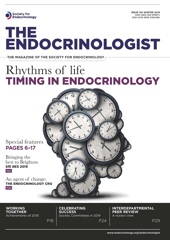Reading this in the depths of winter, you may be looking forward to springtime and the clocks going forward. In the UK, the biannual practice of moving clock times forwards or backwards has been in place since World War I. But this may not always be the case.
In March 2019, the European Parliament voted to abolish clock changes from 2021, instead allowing countries to choose permanent wintertime or permanent summertime (daylight saving time). The Society for Research on Biological Rhythms (SRBR) has published a statement advocating the abolition of daylight-saving time in the USA and, instead, the introduction of permanent standard time.1
There are arguments for and against both positions, involving road safety, farming activity and energy use. But the impact of clock time on our metabolic and cardiovascular health is attracting increasing attention, and is one of the key arguments made by SRBR.
BEHAVIOUR VERSUS BODY CLOCK
Clock time reflects behavioural time – the time we have to get up and go to work, move around, eat our meals and interact with others. Our location in relation to the sun determines when the sun rises, when the sun sets and how long the days and nights are in between. And it is the cycle of light−darkness which is the most potent entrainment cue (‘zeitgeber’) to our intrinsic body clock, through signals from the retina to the hypothalamic suprachiasmatic nucleus.2
Either through changes in clock time (e.g. travelling across time zones and biannual clock changes) or through uniformity of time zones across large geographical areas, behavioural time and body clock time can become misaligned. The body clock, our internal time-keeping mechanism, drives rhythms of physiology designed to match a rhythmic environment. Such behaviour−body clock misalignment can, therefore, lead to mismatches (for example) between when food is eaten and when the body is anticipating a nutritional load, or between actual and anticipated times of physical activity.
Nightshift work and long-haul travel are obvious, extreme examples of circadian misalignment. Yet, it is argued, even the 1 or 2 hours of misalignment produced by daylight saving time (misalignment is more pronounced for people living on the edges of time zones) may have adverse effects in the longer term.
MANIFESTATIONS OF MISALIGNMENT
In humans, circadian misalignment is associated with insulin resistance, hypertension and heart disease,3 with laboratory protocols of circadian disruption reporting higher mean arterial pressure and higher circulating levels of glucose and insulin in subjects, with lower levels of leptin.4 Work in mice has demonstrated altered cardiac conduction and reduced energy efficiency.5 Large population studies of the metabolic impact of clock changes have yet to be undertaken, but there is literature examining activity levels and incidence of myocardial infarction.
If we are sufficiently concerned by the existing evidence, what can we do? On an individual level, awareness of behaviour patterns which conflict with the light−darkness cycle is important. Chronobiologists recommend maximising exposure to natural daylight (which is far brighter than indoor lighting, even on dull days) when we are up and active, with a corresponding minimisation of light exposure at night. Eating meals within a limited window of the 24-hour cycle (‘time-restricted eating’) or, at least, avoiding meals in the late evening, is also attracting interest. But whether and how we effect societal change will be the key debate.
Louise Hunter, NIHR Academic Clinical Lecturer, Centre for Biological Timing, University of Manchester
REFERENCES
- Roenneberg T et al. 2019 Journal of Biological Rhythms 34 227−230.
- Multiple Authors 2016 Science 354 986−1015.
- Kervezee L et al. 2018 European Journal of Neuroscience doi: 10.1111/ejn.14216.
- Scheer FAJL et al. 2009 Proceedings of the National Academy of Sciences of the USA 106 4453−4458.
- West AC et al. 2017 Nature Communications 8 417.






